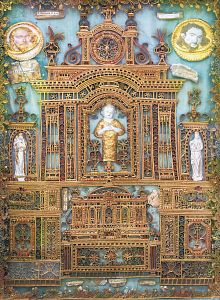

Bristol, Tennessee artist Rebecca Keays has a collection of reliquaries (containers for religious relics). Photo by David Crigger|Bristol Herald Courier
*** Published Thursday, June 11, 2009 in the Bristol (Va.) Herald Courier. ***
BRISTOL, Tenn. – As an artist and a designer, Rebecca Keays found she just could not resist reliquaries.
A reliquary is a container for relics, such as the physical remains of a saint – be it a stitch of clothing, a fragment of bone or possibly some other object associated with a saint or religious figure, said Keays, a Bristol, Tenn., resident.
"The use of reliquaries became an important part of Christian ritual," Keays said.
Keays began collecting reliquaries more than a decade ago, after learning about them in London through antique-loving friends who were always in search of reliquaries in a collector's market.
DISPLAYING RELICS
Raised in the Episcopal church, Keays has long been fascinated by articles and symbols of faith from all cultures, including places in Mexico and Italy.
She has visited the famous French labyrinths at Chartres and Amiens and incorporated these iconic labyrinth images into her paintings and works on glass.
Keays' parents – the late Donald Newell, her father, and her mother, Polly Newell, who now lives in an assisted living home – made to a move to Bristol, Tenn., a little more than 20 years ago.
Then, just a few months ago, Keays followed.
The Utah native, who later lived in states like California and Oregon, brought along her reliquaries.
Reliquaries have been used by several denominations of Christianity, including the Roman Catholic Church and some Anglican churches, Keays said.
"Reliquaries provide a means of protecting and displaying relics," Keays said.
A relic may be contained in a tiny reliquary, like a pendant or a framed box.
SHADOW BOX-LIKE CREATIONS
Many reliquaries were designed to be portable or for personal use, Keays said, while others were made for public display in churches or parades on the saints' feast days or other holy days.
"Early reliquaries were unique, shadow box-like creations," Keays said.
Inside you could find tiny fragments of a saint's bones adorned with dainty labels naming the sainted relic.
Small colored prints or tiny plaster statues of the Christ child – or figures such as John the Baptist – were included and cast from plaster mixed with, allegedly, the ground bone dust of a saint, Keays added.
During the 16th and 17th centuries, nuns in Belgium and France created some of the finest reliquaries, characterized by compositions made of paperolles: filigree-like rolled paper structures that hold the relics and other items in the reliquary in place, Keays said.
By the late 1800s, reliquaries were more widely produced, especially in Italy, where the faithful purchased them when visiting Rome and the Vatican, Keays said as she showed off a couple of pieces in her collection.
By then, she said, the components of the reliquaries were mass-produced, creating a more rigid-looking composition.
In turn, Keays said, the bone fragments or other relics became tinier, often lost in the drop of glue used to hold them in place.
"You see bones. You see hairs," Keays said. "You see bits of fabrics."
ITEMS OF CURIOSITY
How authentic are the relics inside reliquaries?
Are these really the bones of saints?
Keays said that's a matter of debate.
The Catholic church handled the authenticity question of mass-produced reliquaries of the 1800s by literally "sealing at the factory" each reliquary with an orange wax seal of the Pope," Keays said.
"Reliquaries with such seals [have] an easy means of dating the reliquary," Keays said. "Reliquaries may sometimes be dated by the style of the lettering on the labels."
Keays, who studied art at the Rhode Island School of Design, began collecting reliquaries in 1998, when she had a relationship with Antoine Tzapoff, a Parisian painter.
"These are items of curiosity," she said. "These are articles of faith ... It's nice to see something that's a very serious object of someone's faith, because they collected these and lived with them."
All the reliquaries in Keays' collection were probably made in France and Belgium, with a few from Italy, and one hailing from the Basque country of southern France, she said.
The largest in her collection dates back to 1780, she added.
"I think they're incredibly beautiful," Keays said. "They reflect when people had time for such devotion."
IMPRESSIONS AND IMAGERY
Keays is an artist as well as a green/sustainable home designer and builder.
"My paintings reflect a fascination with the diversity and commonality of the iconic images – symbols and language that mankind has used and continues to use – to communicate on various levels through all cultures," Keays said. "My work is all about taking iconic symbols from different cultures."
Keays has shown her work at the Gallery Main Street of Abingdon, as well as galleries across Florida, Oregon and California.
"I have long been intrigued by vessels – or amphoras," Keays said. "They have appeared in my work for years and have become a personal icon. I am attracted by their shape and their multiple functions, all related to containment in various ways – especially as "human vessels' containing our essence, our souls."
YOU SHOULD KNOW
What: Artwork by Rebecca Keays
Info: (423) 914-9406
E-mail: rkeays2@gmail.com